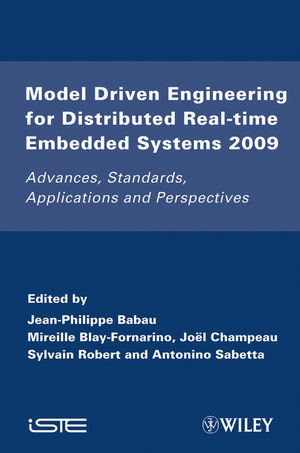Model Driven Engineering for Distributed Real-Time Embedded Systems 2009: Advances, Standards, Applications and PerspectivesISBN: 978-1-84821-115-5
Hardcover
320 pages
September 2010, Wiley-ISTE
 |
||||||
Chapter Summary xi
Chapter 1. Model Transformation: A Survey of the State of the
Art 1
Tom MENS
1.1. Model-driven engineering 1
1.2. Model transformation 2
1.3. Model transformation languages 5
1.4. Model transformation activities 8
1.5. Conclusion 14
1.6. Acknowledgements 14
1.7. Bibliography 15
Chapter 2. Model-Based Code Generation 21
Chris RAISTRICK
2.1. Introduction 21
2.2. The model-driven architecture (MDA) process 22
2.3. The automated approach to code generation 23
2.4. Domain modeling 25
2.5. The executable UML (xUML) formalism 29
2.6. System generation 31
2.7. Executable UML to code mappings 34
2.8. Conclusions 41
2.9. Bibliography 42
Chapter 3. Testing Model Transformations: A Case for Test
Generation from Input Domain Models 43
Benoit BAUDRY
3.1. Introduction 43
3.2. Challenges for testing systems with large input domains 46
3.3. Selecting test data in large domains 52
3.4. Metamodel-based test input generation 58
3.5. Conclusion 67
3.6. Acknowledgements 68
3.7. Bibliography 68
Chapter 4. Symbolic Execution-Based Techniques for
Conformance Testing 73
Christophe GASTON, Pascale LE GALL, Nicolas RAPIN and Assia
TOUIL
4.1. Context 73
4.2. Input output symbolic transition systems 79
4.3. Symbolic execution 84
4.4. Conformance testing for IOSTS 87
4.5. Concluding remarks 96
4.6. Bibliography 101
Chapter 5. Using MARTE and SysML for Modeling Real-Time
Embedded Systems 105
Huascar ESPINOZA, Daniela CANCILA, Sébastien GÉRARD and
Bran SELIC
5.1. Introduction 105
5.2. Background 108
5.3. Scenarios of combined usage 113
5.4. Combination Strategies 125
5.5. Related work 130
5.6. Conclusion 133
5.7. Acknowledgements 134
5.8. Bibliography 134
Chapter 6. Software Model-based Performance Analysis
139
Dorina C. PETRIU
6.1. Introduction 139
6.2. Performance models 142
6.3. Software model with performance annotations 148
6.4. Mapping from software to performance model 155
6.5. Using a pivot language: Core Scenario Model (CSM) 158
6.6. Case study performance model 160
6.7. Conclusions 162
6.8. Acknowledgements 163
6.9. Bibliography 163
Chapter 7. Model Integration for Formal Qualification of
Timing-Aware Software Data Acquisition Components
167
Jean-Philippe BABAU, Philippe DHAUSSY and Pierre-Yves PILLAIN
7.1. Introduction 167
7.2. System modeling 170
7.3. Variation points modeling 182
7.4. Experiments and results 189
7.5. Conclusion 194
7.6. Bibliography 195
Chapter 8. SoC/SoPC Development using MDD and MARTE Profile
201
Denis AULAGNIER, Ali KOUDRI, Stéphane LECOMTE, Philippe
SOULARD, Joël CHAMPEAU, Jorgiano VIDAL,
Gilles PERROUIN and Pierre LERAY
8.1. Introduction 201
8.2. Related works 203
8.3. MOPCOM process and models 206
8.4. Application 210
8.5. System analysis 211
8.6. Abstract modeling level 214
8.7. Execution modeling level 216
8.8. Detailed modeling level 220
8.9. Tooling Support 223
8.10. HDL Code Generation 225
8.11. Conclusion 228
8.12. Acknowledgements 229
8.13. Bibliography 229
List of Authors 233
Index 237



